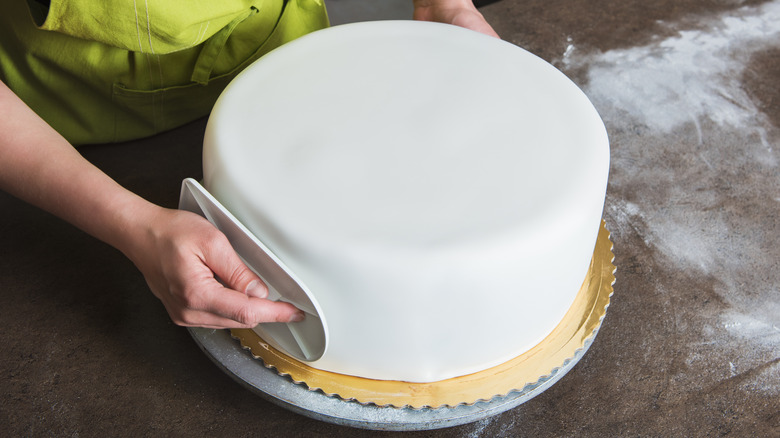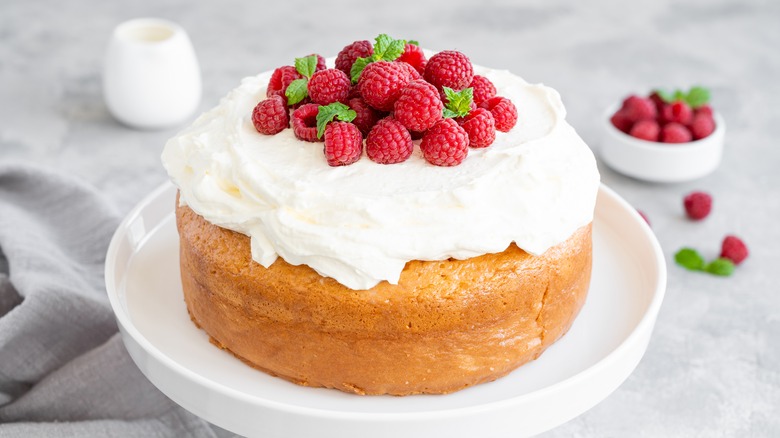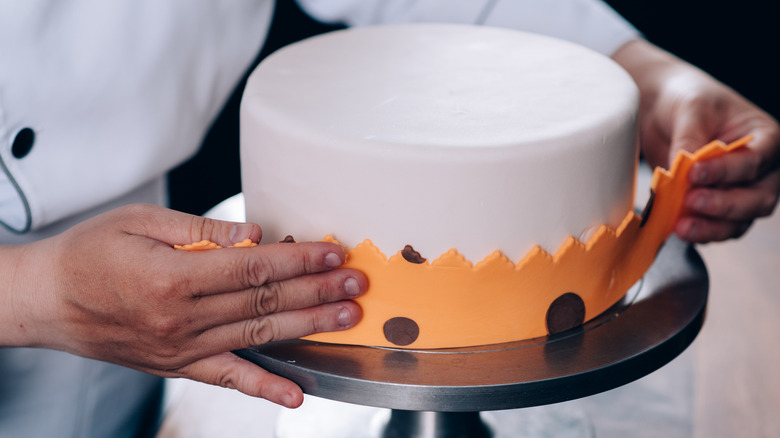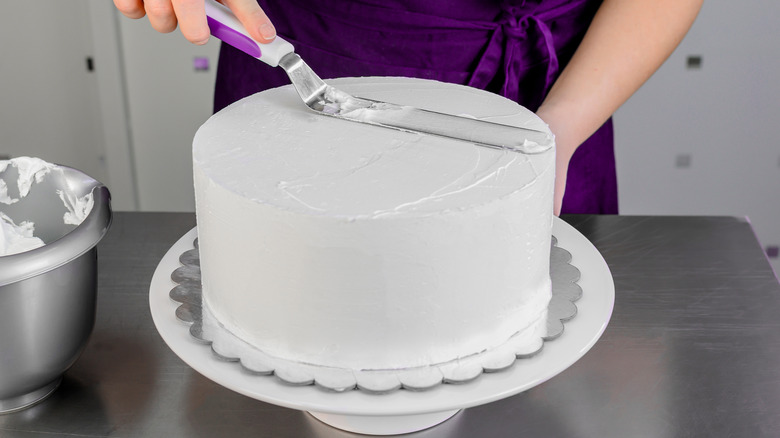Cream Icing Vs. Fondant: What's The Difference?
The history of cake decoration isn't actually all that sugary. Rather, it began in a much fruitier fashion. Some of the oldest kinds of cakes were fruitcakes. They date back to the days of ancient Rome and were made of seeds, dried fruits, and barley mash (via What's Cooking America). Confectionary Chalet claims that it wasn't until Elizabeth I's reign in England (1558 to 1603) that people began topping cakes with something other than fruit. Almond paste was used as well as sweetmeats (crystallized fruit). It wasn't until King Charles II took the throne in 1660 that English bakers stepped it up a notch and started using sugar and icing on their cakes, though only for the wealthiest clients.
Today, we have a whole slew of cake toppings to choose from. Vanilla buttercream, meringue, and chocolate ganache are all wonderful and delicious examples of how far we've come in cake decoration over the centuries. There are so many things to choose from in modern-day baking that some of the most basic, but yummy, cake decorating recipes get overlooked — like that of simple cream icing and the flat but classic fondant.
What is cream icing?
Cream icing or frosting is different from buttercream frosting, which uses butter, sugar, and milk to create a thick, perfect-for-spreading cake topping. Cream frosting, however, has a small adjustment to its ingredient list, but it dramatically changes its texture. According to Foodiosity, cream icing tends to only use heavy cream and powdered (confectioners') sugar, making a kind of whipped cream. This whipping cream is significantly lighter than buttercream, which tends to be heavier due to the addition of butter. The light airiness of the cream icing makes it difficult to use as a cake topping and nearly impossible to use as a filling unless another thickening agent is added.
Two Sisters Crafting suggests that if you want something that is lighter than buttercream, you should certainly look to cream frosting, especially if you want your fluffy Orange Chiffon Cake Recipe not to be weighed down. First, add heavy cream or whipping cream into a bowl and mix until peaks form. From there, add powdered sugar and a secret, stabilizing ingredient: pudding mix! You can use white chocolate, vanilla pudding, or cheesecake pudding mix — whatever your heart desires. Whip until incorporated, but do not overmix or you'll end up with some sweet-tasting butter.
What is fondant?
Fondant is something you've definitely seen used on cakes before. It is known to give your desserts a nice clean finish and is perfect for making those you see on competitive baking shows (via GoodTo). Fondant is generally a good thing for you to know how to make if you like to bake, and it is wonderfully simple! Bob's Red Mill says that, for a basic rolled fondant recipe, you only need sugar, water, and corn syrup, though you can also make it out of powdered sugar and melted marshmallows, which is a much less common method to use. Rolled fondant will form a dough-like texture, which you then roll out into a sheet and shape over your cake.
For some helpful tips and tricks regarding fondant making, More Than Baking recommends adjusting the flavor. Fondant tends to be a bit bland in comparison to other frostings and icings, so feel free to add in natural or artificial food flavoring to give it an extra delicious kick! Fondant is also a great decorating choice if you're worried about the temperature of your cake since it holds up better than dairy-based toppings; however, if you are rolling out your fondant in a hot room, it may become too soft to work with, so try to keep your workspace cool and dry.
The major differences between cream icing and fondant
These cake toppings, while delicious, are very different from one another. Cream frosting is dairy-based, light, and sensitive to environmental changes, whereas fondant is a little more stable and far less perishable. You really only want to make cream icing right before you're ready to use it, especially if it doesn't have a stabilizing agent added to it. Bare Feet in the Kitchen claims that, if you do need to store it, you should seal cream frosting in an airtight container. Once it's been applied to a cake, you should only plan on it looking good for about two to three days in the refrigerator. After that, it will begin to weep. As for fondant, Sweetness & Bite says that the best way to store leftover or pre-prepared sugar sheets is by keeping them flat, placing them on non-stick baking paper, and sealing them in something airtight with a little cornstarch or icing sugar dusted on top to keep them from sticking to anything. Applying shortening to the fondant will also help to keep it from drying out if you plan on storing it outside of the refrigerator.
Applying cream icing or fondant to your cake will look different too. According to Instructables, you'll want to lift the sheet of fondant gently and drape it over your arm, before then lowering the fondant directly on top of the cake. You'll need to smooth the top and the sides down while trying to avoid wrinkles, air bubbles, or tears. Meanwhile, Bare Feet in the Kitchen says that, because cream icing is so light and amiable, it is best to use an offset spatula to spread the icing on the top and sides of your cake.



